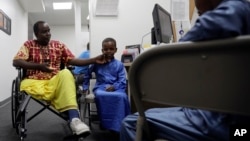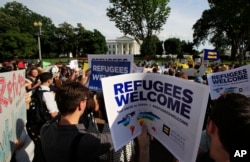The U.S. refugee program is off to a sluggish start in the new fiscal year, following newly announced screening procedures and a significant reduction in expected arrivals in the coming 12 months.
About 1,200 refugees arrived in October, according to data made public through the U.S. State Department.
The program, already cut down to the lowest ceiling in its 38-year history for the current fiscal year, would need to welcome 3,750 refugees a month to meet the upper limit of 45,000. The current rate, if continued, would mean the country would fall short of even the halfway point to the ceiling set by President Donald Trump for fiscal 2018, which began October 1.
Refugee advocates called attention to the low monthly numbers in an online campaign Monday.
Historically, the first month of the fiscal year isn't indicative of how the rest of the year will go, however. There are years when the program started off strong in October, like fiscal 2011, when nearly 4,800 refugees arrived. By the end of the year, the total number fell short of the ceiling — only 71 percent of the 80,000 available spots were filled.
And in fiscal 2014, the year started slowly, barely breaking 1,800 arrivals that October, far short of the monthly average of about 5,800 needed to meet the ceiling of 70,000. Nevertheless, the program picked up speed throughout the year, with only three unused resettlement spots by the end.
No required number
However, the 45,000 set for FY2018 is an upper limit - not a requirement or even a target. Despite public protests, the government could allow in a total number of refugees well under that ceiling, as it did last year - when roughly 54,000 of the anticipated 110,000 arrived, following decisions by Trump’s cabinet and messaging from the president about his perceived security risk of refugees.
In late October, the administration announced it would add procedures to the refugee admittance process: Refugees from 11 countries will face additional intensified screening during a 90-day review period, and will be admitted only on a case-by-case basis in those months.
Citing senior administration officials, Politico identified the countries subject to the additional "in-depth threat assessment" as Egypt, Iran, Iraq, Libya, Mali, North Korea, Somalia, South Sudan, Sudan, Syria and Yemen.
The last two years have shown that the program — which is based on the ceiling determined by the president at the start of a fiscal year — can change shape throughout the year.
Former President Barack Obama's second-term administration added resources to process more Syrian refugees awaiting resettlement in 2016. Trump slowed the program significantly during his first nine months in office.








